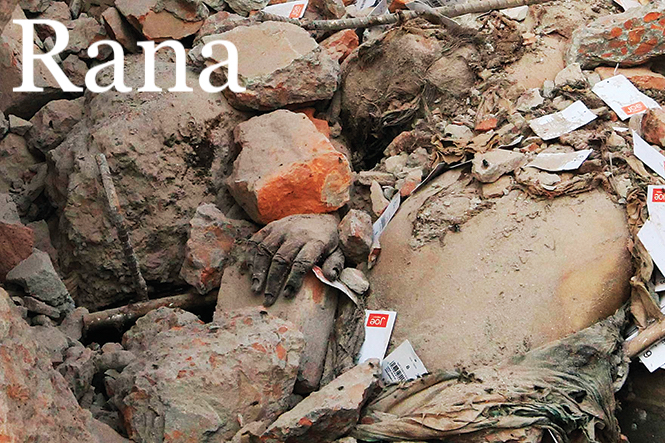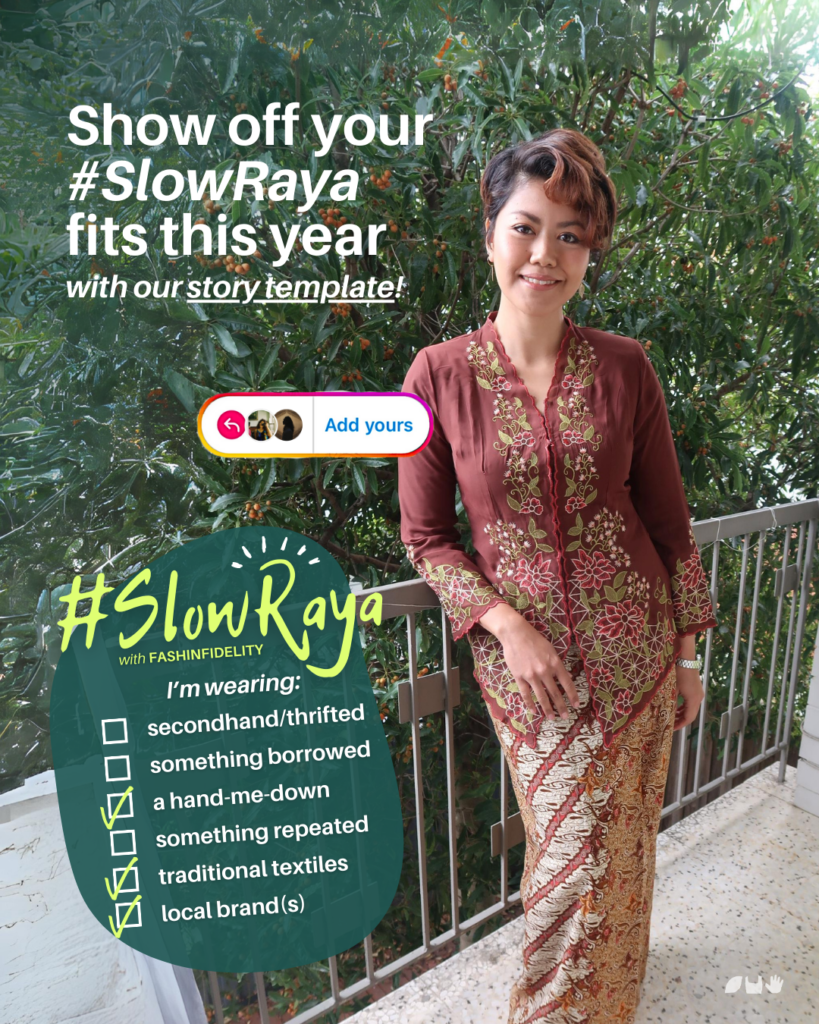The leaping bunny logo is synonymous with the cruelty-free cosmetics movement, starving polar bears are associated with the effects of anthropogenic climate change, and sea turtles growing up with deformed shells is a reminder of how plastic is ruining our oceans as a habitat for sea life.
But when it comes to Fast Fashion, does the imagery of dead people come up when you’re about to pay for that $10 piece of clothing on sale? I suspect not, because human suffering doesn’t create emotional triggers for humans as much as animal suffering does.
2830 words; 14 mins read
Updated 24 September 2018

Fast Fashion’s Mascot: Body of a female garment worker trapped under the debris of the collapsed building at Savar, Bangladesh April 26, 2013. Photo: Abir Abdullah/Alexia Foundation

Some symbols you might find on the packaging of your haircare products. Source: Naturally Curly
For centuries, animals have been used in marketing, campaigning, and activism, because animals are strong emotional triggers and are effective at supporting a narrative.
It’s no surprise that the use of imagery of animals in pain or suffering animals, partnered with clever context and messaging for Calls to Actions are effective in changing our attitudes. Graphic images, which are hard to ignore and impossible to forget, create an emotional connection to the issue it is promoting and raise ethical discussions. Just think about successful campaigns you’ve donated to or supported – carrying your own bags to the supermarket, boycott palm oil (orang utans and illegal destruction of their habitat), becoming vegan (cattle and their enormous greenhouse gas footprint), and not buying caged eggs (terrible farmed conditions for hens) – they all come from powerful imageries stuck in your mind. Coupled with other factors such as discussions with friends, watching documentaries and lifestyle shows, following in the footsteps of a celebrity you admire, and campaign actions from groups you subscribe to, it’s easy to empathise with the cause.
I have been thinking about an easily identifiable mascot or symbol for the destructive Fast Fashion industry, but no animals came to mind. Truth be told, there already exists a mascot – underpaid garment workers.
And worse – the deaths of underpaid, overused, unappreciated garment workers that worked for Fast Fashion.
The Rana Plaza collapse in Bangladesh is nearing its fifth year anniversary, where Fast Fashion’s true colours came to the fore in mass media. TV outlets covered the deadliest garment industry accident in modern history, and Fashion Revolution, a not-for-profit organisation committed to enacting genuine change on worker rights and safety, was formed. The catastrophe injured nearly 2,600 and killed more than 1,138, including rescue workers.
Animal mascots are effective, but humans not so
Truth be told, there already exists a mascot – underpaid garment workers. And worse – the deaths of underpaid, overused, unappreciated garment workers…
Some of the international brands implicated in the tragedy are Benetton (Italy), Bon Marche (UK), Cato Fashions (USA), The Children’s Place (USA), El Corte Ingles (Spain), Joe Fresh (Loblaws, Canada), Kik (Germany), Mango (Spain), Matalan (UK), Primark (UK/Ireland) and Texman (Denmark.) The saddest thing about the tragedy was it was an avoidable one – but greed and political corruption were the order of the day instead of workers’ safety.
It seems that the pain of experiencing a fatal workplace disaster doesn’t make us question ditching Fast Fashion enough. Let’s not forget also the survivors of the Rana disaster whom are now suffering long-term disabilities that make living in Bangladesh that much harder.

Images of animal cruelty break our hearts. Over 70% of cruelty to any animal involves dogs.
Humans can’t relate to other humans as much as we’d like
I conducted a quick poll with my friends on Facebook concerning the question of whether humans are more likely to empathise with animals or with other humans in relation to suffering and/or pain. Animals won (at the time of writing – 15 votes for animals; 10 for humans; 3 voted humans aren’t capable of empathy for each other, let alone animals – *ouch*.)
But let’s go back to science quickly. We all respond differently to imagery, whether still or moving.
There are images that evoke positive emotional responses in the human brain. The most powerful are of:
- portraits (close up)
- babies
- cute animals
- inspiration / motivation
- nostalgia
- expressions of happiness
- nature.
Images of pain and suffering can most definitely elicit a commitment, a positive change from within an individual, or both. PETA’s (People for Ethical Treatment of Animals) controversial animal rights campaigns come into mind for example and even though they often receive mixed responses, some have been highly successful at shifting perceptions.
Having said that, graphic imagery of animals being gassed for food production won’t necessary provoke or motivate an animal-free diet and can be a complete put off for some. Inversely, a healthy image of someone who has become vegan in recent years and posts colourful Instagram-worthy photos of their food evoke positive aspiration, and might just encourage you to take that leap of faith.


Portraiture evoke strong emotion in human beings. Photo: Ben Konfrst via Unsplash.com
Even though some may remember what happened at Rana in 2013, we are quick to detach ourselves from its bigger social impacts.
Throughout my thirty-five years of living I haven’t been immune to numerous human plights around the world. Even though my generation read about the great wars but never experienced them, crises around the world involving children, the sick and diseased, the treatment of workers in underdeveloped countries, battles waged against others due to differences in beliefs, and rebelling of governments due to corruption and atrocities still plague our news channels.
Dehumanisation is the reason my Facebook poll result wasn’t kind towards human beings. Dehumanisation is viewed as a central component to intergroup violence because it is frequently the most important precursor to moral exclusion, the process by which stigmatised groups are placed outside the boundary in which moral values, rules, and considerations of fairness apply. David Livingstone Smith, director and founder of The Human Nature Project at the University of New England, argues that historically, human beings have been dehumanising one another for thousands of years.
News stories on TV, print and online platforms perpetuate this state and perhaps we, as humans, have come to terms with the unpleasant side of the human race. We are desensitised to human plight, whether it be basic human rights, or on social justice issues, like what a fair wage looks like for a certain occupation.

Relatives of the victims stand at the site of the Rana Plaza building, in this 2015 photo. Photo: A.M. Ahad/AP
Our internal struggles for ethical consciousness
Sometimes though, we are reminded of our innate human ability to connect with others. If I may, remember when images emerged of the lifeless body of three-year-old Alan Kurdi that washed up on a beach in Turkey in September 2015? It evoked a public response like no other, because here was an innocent and helpless child, a victim of adults dehumanising each other – in this case, the Syrian civil war had erupted four years earlier.
Two-and-a-half years on, we had forgotten that that particular photograph shocked world leaders into action on the refugee crisis.
And what about the media’s role in advancing ethics? Stories of little, or even big wins in the defence of the environment, fights for human rights, and government corruption crackdowns don’t get as much coverage in the mainstream news. It’s easy to conclude that one person, as in, YOU – can’t possibly play a role in the aftermath of Alan’s fate.
I’m no psychologist, but this incapability to prevent Alan’s death really does make us despise the human race most days! We can empathise with the stories of the refugees but can never fully understand it. (Unless you were born in a war-town country.)
Stories of little, or even big wins in the defence of the environment, fights for human rights, and government corruption crackdowns don’t get as much coverage in the mainstream news.
Humans are evil
For the one day that you are empowered enough to contribute to a cause and take action, there will be many more days where there are so many crises involving injustices in this world that seem out of reach and unsolvable for the average person. Let’s not kid ourselves. This feeling of powerlessness to enact change affects all of us, especially if we are not located anywhere near the crisis – regardless of whether you are a citizen of a First World Country (i.e. generally privileged) or not. In my case, Australia is so far from Europe. The best I could do was to lobby the government (through campaigns by Getup!, a not-for-profit movement and other similar organisations) to take in more Syrian refugees into the country – bar packing my bags, leaving my job and get on a plane headed to the Mediterranean to dosomething.
I have likened this conflict of personal ethics to this realisation: It’s about what is feasibly under your sphere of influence, and what is not. International, different time-zone, another continent-type crises are too displaced for even our hearts to reach out to, and even though we love the thought of being ‘citizens of the world’ (for example, when it comes to holidays and vacations), we shy away from that notion when it comes to helping other people.

Polar bears are the poster child of the effects of climate change. Photo: Mario Hoppmann/imaggeo.egu.eu
We need break it down in human scale..
There is a reasonable explanation for all this: distance. It is a significant barrier for even the most well-meaning of us, and time again we let the news stories run, we listen, and we get on with dinner.
As someone who has worked in the environment sector all my career, I have also accepted the fact that the terms climate change and global warming are so damn unappealing. The reason why it is hard for people to relate to understanding how the climate works is because geologic time scales are long – too long for the human mind to really comprehend. “Over tens… and hundreds of millions of years, the Earth has changed from something unrecognisable to the planet we see on maps, plastic globes, and photos from space”, as Peter Gleick, internationally recognised climate and water expert, explains here. For a large percentage of the Earth’s age, there exists no USA, California, Australia, China, or Mount Everest. Humans cannot relate to these changes. Our perception of time is short – measured in days, months, years, or decades, not millennia or eons (Google it.) And our perception of the world around us is similarly driven by events with human time scales. It’s hard enough to think about what I’ll get up to this weekend, let alone how the planet will look like from outer space in two-hundred years. Heck, when I talk to my younger siblings about the importance of retirement savings, they laugh! Because they don’t think being sixty-five years old is even possible right now.
One of the ways humans relate is symbols and mascots, something that represents a complex issue but conveyed at a level that is easy to grasp. In the fight against climate change, who can forget this heart-wrenching video that went viral of a polar bear clinging to life in Canada’s Baffin Islands?
The thing is, all suffering is terrible. It’s now easy to see what transpired from my Facebook poll of human empathy towards animals. The emotive theory pretty much got decoded, in humanscale. (Ooohhh……. snap!)
For the one day that you are empowered enough to contribute to a cause and take action, there will be many more days where there are so many crises involving injustices in this world that seem out of reach and unsolvable for the average person.
It’s not hard to relate. Let’s give this another go.
This situation does not need to be completely discouraging, however.
Remember the old adage, ‘Think Global, Act Local’? Yes! This is where YOU can be an agent of change.
Every time you are faced with a problem that may seem impossible to tackle, I cannot stress how important it is that we don’t lose sight of the bigger picture. Snap yourself out of the ‘everything is too hard basket’ and re-wire your perspective. Contribute to the issue from your own sphere of influence! Because, believe me, every single human (human animal and non-human animal) legacy matters. It really does.
The phrase ‘Think Global, Act Local’ was first used in the context of environmental challenges, but has now been used in various settings, including planning, education, mathematics, and business. If you wanted to achieve change and improvement, you can’t wait for global legislation or global action. The best course of action is to drive change yourself. YOU could act to reduce YOUR OWN environmental impact by, for example, consuming less energy or water, or only buying clothes that you need (preferably second hand.) Acting locally starts to address what you see as a global issue.

You can relate. Start changing the world for the better at a local level. Image source: LauraTrotta.com
Every time someone forgets to turn the lights off in the office or at home, I remind them of the polar bear’s hardship to hunt for food. Any human, and any animal, needs food! You can’t argue what you saw in the video, because our unsustainable rate of energy consumption and development really is affecting them. Normal people (with feelings) can’t help but feel so sad for them. It’s an easy connection to make. Polar bear survival = turn the lights off.
Don’t forget, actions also speak louder than words. Doing what YOU do is a step closer to having OTHERS do as YOU do.
Here is a quick rundown of the really, really, simple things YOU can do now, in each of the problem areas we’ve touched on above:
- Do not support the unnecessary and cruel testing of chemicals and formulas on animals. Ditch your current beauty products once they are finished and switch to cruelty-free brands, pronto! There are so many!!! You don’t need to make a list. Every time a bottle or jar of something is finished – shampoo, conditioner, make up, body lotion, etc, you should research the brands you want to purchase next. There really are no excuses.
- Help reverse the trend of global warming. Empower women and girls in underdeveloped nations to reach for tertiary education. Try to not use your car for short distances. Eat less meat. Check out this story on 100 Practical Ways to Reverse Climate Change.
- Do not support the continuation of demand for plastic. Say no to plastic bags. Stop using plastic straws. Carry a reusable water bottle (and bring your own water!) Quit smoking.
Ditch Your Fast Fashion Habits
As for fashion, let’s not even use that word. Let’s just call it for what it is: the shirt off your back to protect you from the elements. Think about how many items of clothing is basically necessary for your wardrobe, which goes hand in hand with function.
As we commemorate the events that transpired prior, during and after the Rana Plaza disaster, may I remind you – making clothes doesn’t need to have a human cost. We should all work in satisfactory conditions, get paid for a day’s worth, and come home safe. The death toll was 1,138, with many more injured. That’s way too many. And that doesn’t include other factory fires in Bangladesh and others around the globe.
So let me tell you: if you think not buying a $10.00 top is not making an impact on the fast fashion industry, you are truly wrong. Your individual action and others who do the same are telling the world the horrid conditions these workers have to endure to make a living is unacceptable. You are avoiding THIS from happening again:

Haunting photo from the Rana Plaza collapse in the May 2013 edition of TIME magazine. Photo: Taslima Akhter
I have been researching the apparel-making industry, the rise of Fast Fashion and its supply chain and ethical issues for a while now. Yes, we need clothes. But we don’t need fashion. We can look stylish however, and wear items that match our personal style, as well as feeling great in them, right?
You can achieve this. If you’re worried about price, shop second-hand or organize a clothes-swap with your friends. When I did not shop for new clothes in 2007, and then 2017, I managed fine. If I needed a wardrobe refresh, I’d go to my favourite op-shop, the North Perth Red Cross store on Fitzgerald Street. Look for pieces that match your existing wardrobe, that can be worn/layered for all seasons. For starters, as a rule, you can buy new underwear and new running or work out shoes if you’re an active person. You can accept gifts but try not to gift somebody else new clothes. There are other rules for years 2, 3, and so forth, which I’ll get to later on.
One thing that really had an impact on me was to stop subscribing to this online retail marketplace, called BrandsExclusive.com.au. I did that in 2016. Not seeing their weekly or daily specials in my inbox really helped me stay away from unnecessary spending. I highly recommend unsubscribing to most, if not all of online shopping temptations.
The solution is not to boycott clothes from certain brands, because the fashion supply chain is a complex relationship and transparency cobweb. Instead, give some thought about the price of the product, because cheap clothes = dead people (see image above.) Say no to Fast Fashion now.
When all is said and done, the solutions are within your reach, after all. Take action today. You CAN be a power of change.

Join us in our Slow Fashion movement with the hashtag #ConscientiousFashionista and #wardrobetruths on Instagram, and follow us at @fashinfidelity
Tags: #conscientiousfashionista #fastfashion #slowfashion #ethicalfashion #ecofashion #sustainablefashion #greenfashion #sustainability #wardrobetruths #fashioneducation #fashionisnolongertrendy #fashion #ranaplaza #bangladesh #FashionRevolution #thinkglobalactlocal
Further reading:
- Srivastava, K. and Das, R. C., “Empathy: Process of adaptation and change, is it trainable?”, Industrial Psychology Journal, India, https://www.ncbi.nlm.nih.gov/pmc/articles/PMC5248406/ (last accessed 28 March 2018)
- “How Do Graphic Images Affect Animal Advocacy?” Striking at the Roots, https://strikingattheroots.wordpress.com/2012/11/01/how-do-graphic-images-affect-animal-advocacy/ (last accessed 28 March 2018)
- “Funny Animals”, (n. d.), in Wikipedia, https://en.wikipedia.org/wiki/Funny_animal (last accessed 30 March 2018)
- “The Uniqueness of Human Suffering”, (n. d.) https://speakingofresearch.com/2015/01/12/the-uniqueness-of-human-suffering-suffering-from-pain/ (last accessed 28 March 2018)
- Tierney, L., “6 Types of Images That Elicit an Emotional Response”, Shutterstock, 5 May 2017, https://www.shutterstock.com/blog/6-types-of-images-that-elicit-an-emotional-response (last accessed 28 March 2018)
- Garfield, S., “Living on Thin Ice”, The Guardian UK, 4 March 2007, https://www.theguardian.com/environment/2007/mar/04/climatechange.activists (last accessed 30 March 2018)
- Stone, S. M., “The Psychology of Using Animals in Advertising”, Northwestern Oklahoma State University, date unknown, https://www.huichawaii.org/assets/stone_sherril_the_psychology_of_using_animals_in_advertising_ahs2014.pdf (last accessed 28 March 2018)
- “Increasing Transparency in Fashion Using Blockchain”, Provenance, https://www.provenance.org/case-studies/martine-jarlgaard (last accessed 31 March 2018)




